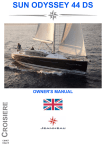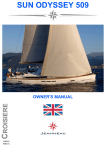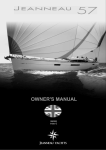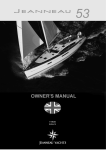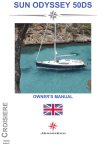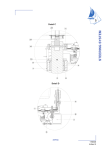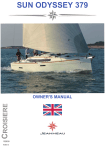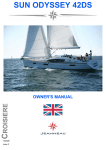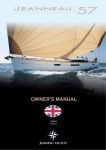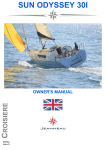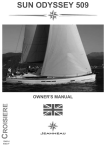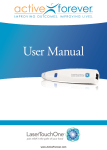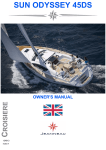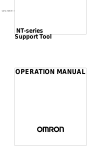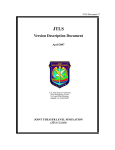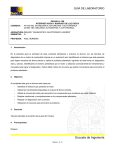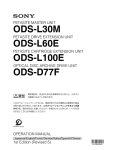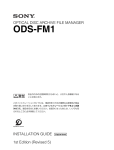Download 10 - NYB Conwy
Transcript
SUN ODYSSEY 439
CROISIERE
OWNER'S MANUAL
129254
Index D
WELCOME ABOARD
Madam, Sir,
You have just taken delivery of your new JEANNEAU boat and we thank you for the
confidence you have shown us in ordering a vessel of our brand. The whole JEANNEAU team
welcomes you aboard.
A JEANNEAU is made to last, in order to bring you all the pleasure you expect from a vessel
over a period of many years. Each boat is subject to the utmost attention to detail from the
design stage right through to launching.
This manual is meant to help you to enjoy your boat comfortably and safely. It includes the boat
specifications, the equipment provided or installed, the systems and tips on her operation and
maintenance. Some of the equipment described in this manual may be optional.
Your JEANNEAU dealer will be able to help and advise you in the use and maintenance of
your boat.
Read this user's guide/owner's manual carefully and get to know your boat before using it.
The better you know your vessel the more pleasure you will get from being at the helm.
The sea is a source for learning. Caution based on a knowledge of one's own limits and those
of the boat is the pre-requisite for an accomplished sailor.
Even when your boat has been adapted for them, the sea and wind conditions corresponding
to the design categories A, B, C and D may vary, ranging from severe conditions to strong
storms subject to the risks of exceptional waves and gusts of wind, this meaning they are
dangerous conditions in which only an experienced, fit and well trained crew manoeuvring a
well maintained boat can sail in a satisfactory manner.
This user's guide/owner's manual is not a course in safety at sea or about sailing sense. If this
is your first boat or if you change to a new type of boat which you are not used to, get some
training in boat control and sailing to ensure your safety and comfort. Your dealer, your
international sailing association or your yacht club will be very happy to recommend local
sailing schools or professional instructors.
Make sure the sea and wind conditions will correspond to the category of your boat and you
and your crew are able to handle the boat in these conditions.
Always listen to the weather forecast before you put out to sea.
Keep this user's guide/owner's manual in a safe place and hand it over to the new owner if
you sell your boat.
You are advised to keep all the instructions and manuals provided by the boat equipment
manufacturers (accessories...) in the same place as this manual
-1/152
INTRODUCTION
THE USERS OF THE BOAT ARE INFORMED OF THE FOLLOWING:
This user guide/owner's manual is not a maintenance or repair guide. In case of difficulty
do not hesitate to call on the services of your concessionaire JEANNEAU.
Any alterations which may affect the safety specifications of the boat must be assessed,
carried out and recorded by persons qualified to do so. Any change in the distribution of the
vessel's mass (adding a radar, altering the mast, changing an engine, etc) may affect the
stability, trim and performance of your boat.
The SPBI shipyards may not be held responsible for any alterations which they have not
approved.
The complete crew must be equipped appropriately.
In numerous countries, a licence, an authorization or a training course is requested. Make
sure you have this legal authorization before you use your boat.
Adapt the use of your boat to her condition that wears out with time and use.
Any boat, however solid she may be, may be severely damaged if badly used. This is not
compatible with safe navigation. Always adapt the speed and direction of your boat to the
conditions of the sea.
The boat shall not be loaded more with than the maximum load recommended by the
builder, in particular the total weight of the food supplies, of the different equipment that are not
supplied by the builder and of the persons on board.
The weight of the boat shall be properly distributed.
The stability is reduced when you add weight in the upper parts.
In case of heavy weather, the hatches, lockers and doors shall be closed in order to
minimize the risk of water coming in.
Breaking waves are a serious threat to stability.
The water in the bilge shall be kept at its minimum.
The stability may be reduced when you tow a boat or when you lift heavy weights with the
davits or the boom.
If your boat is equipped with a liferaft, carefully read the instructions. The boat must have
on board all the proper safety equipment (lifejackets, buoys, harness, flares, liferafts, etc.)
depending on the type of vessel, its certification, the country, the weather conditions
encountered, etc.
The crew must be familiar with the use of all the safety equipment and the emergency
safety procedures (MOB, towing etc.). Sailing schools organise regular training sessions.
1/152
Anyone on the deck shall wear a life jacket or a buoyancy aid.
The safety regulations as defined by the sailing code and enforced by the ’’COLREG’’ should
be observed.
NAME PLATE:
Some of the data is shown on the manufacturer's plate fixed to the boat. The explanation of the
data is given in the appropriate chapters of this manual.
IDENTIFICATION OF VESSEL:
The vessel's identification is found on the builder's certificate delivered with the boat and is
engraved on the starboard aft side.
So as to be able to continuously improve their product the SPBI shipyards reserve the right to
make any alterations in design, layout or equipment which they judge necessary.
That is the reason why the specifications and information given are not contractual, they may
be modified without prior notice or up dates.
This owner's manual is designed in accordance with the ISO 10240 standard requirements, it
has a general purpose and it may sometimes list some equipment or accessories or deal with
some points or questions that are not relevant to your own boat.
The different warnings used throughout this guide are broken down as follows.
DANGER
Indicates the existence of a serious inherent danger with a high risk of death
or serious injury if the appropriate precautions are not taken.
WARNING
Indicates the existence of a danger which could lead to injury or death if the
appropriate precautions are not taken.
PRECAUTION
Indicates a reminder of safety practice or draws attention to dangerous practices which could
cause injury to persons or damage to the vessel or to its components.
ADVICE - RECOMMENDATION
Indicates a recommendation or advice for carrying out manoeuvres appropriate for the
planned manoeuvres.
2/152
HISTORY OF UPDATES
• Index A ........................................................................................................................ 03/2011
• Index B ........................................................................................................................ 04/2011
• Index C ........................................................................................................................08/2012
• Index D ........................................................................................................................06/2014
3/152
CONTENTS
SUN ODYSSEY 439 Anglais
Update 06/2014
Index D
Code: 129254
Total number of pages: 152
INTRODUCTION
Chapter 1 ...... SPECIFICATIONS AND WARRANTY............................................Page 7
Chapter 2 ...... SAFETY ........................................................................................Page 13
Chapter 3 ...... HULL .............................................................................................Page 35
Chapter 4 ...... DECK ............................................................................................Page 39
Chapter 5 ...... STEERING SYSTEM ....................................................................Page 49
Chapter 6 ...... RIGGING AND SAILS...................................................................Page 55
Chapter 7 ...... INTERIOR .....................................................................................Page 73
Chapter 8 ...... WATER AND SEWAGE WATER .................................................Page 79
Chapter 9 ....... ELECTRICAL EQUIPMENT .........................................................Page 91
Chapter 10 .... ENGINE.......................................................................................Page 113
Chapter 11 .... LAUNCHING ...............................................................................Page 143
Chapter 12 .... WINTER STORAGE....................................................................Page 147
PERSONAL NOTES
5/152
1
SPECIFICATIONS AND WARRANTY
TECHNICAL SPECIFICATIONS
CERTIFICATION
DESIGN CATEGORY
YOUR BOAT
7/152
TECHNICAL SPECIFICATIONS
L.O.A .............................................................................................................................13,34 m
Hull length ......................................................................................................................12,99 m
L.W.L..............................................................................................................................12,00 m
Overall width ....................................................................................................................4,24 m
Beam................................................................................................................................4,24 m
Waterline beam................................................................................................................3,50 m
Air draught - Maximum...................................................................................................19,90 m
Keeled version - Shallow draught keel
Draught ....................................................................................................................... 1,60 m
Ballast weight............................................................................................................3 150 kg
Light displacement ....................................................................................................9 960 kg
Keeled version - Deep draught keel
Draught ........................................................................................................................2,20 m
Ballast weight............................................................................................................2 850 kg
Light displacement ....................................................................................................9 640 kg
CERTIFICATION
Version: Shallow draught keel
CE Category
Persons maximum
Displacement with maximum load
Maximum load recommended by
the builder
A
10
12 980 kg
B
11
13 030 kg
C
12
13 100 kg
D
12
13 040 kg
3 020 kg
3 070 kg
3 140 kg
3 080 kg
Version: Deep draught keel
CE Category
Persons maximum
Displacement with maximum load
Maximum load recommended by
the builder
A
10
12 660 kg
B
11
12 710 kg
C
12
12 780 kg
D
12
12 720 kg
3 020 kg
3 070 kg
3 140 kg
3 080 kg
Including the mass of the persons who are authorized on board (75 kg/165 lbs per adult), the
supplies, the liquids that can be used (fresh water and fuel) in fixed completely full tanks, the
additional loads, the optional equipments, the liferaft and the scope for load.
Total mass of liquids (all tanks full) ..................................................................................850 kg
Freshwater capacity............................................................................................................330 l
Extra tank............................................................................................................................200 l
Fuel capacity.......................................................................................................................200 l
Refrigeration unit capacity ..................................................................................................190 l
Sewage water capacity ...............................................................................................80 l + 80 l
Recommended maximum power .................................................................................. 39,6 kW
Maximum motorisation mass ...........................................................................................241 kg
Battery capacity - Engine ................................................................................................... 110A
Battery capacity - Service ............................................................................................ 2 x 110A
Battery capacity - Spare battery................................................................................... 2 x 110A
Battery capacity - Bow thruster ...................................................................................... 2 x 50A
Cabins....................................................................................................................................2/3
Architect ................................................................................ Philippe BRIAND, Garroni Design
Note: The capacities indicated are maximum (including options).
8/152
2
1
Mainsail (classic) - Classic ......................................................... 49,5 m
Genoa - Classic ........................................................................ 41,05 m2
Furling mainsail ...........................................................................39,3 m²
Mainsail (classic) - Performance .................................................49,6 m²
Genoa - Performance ................................................................. 54,7 m2
Tacking jib ...................................................................................35,3 m²
Asymmetric spinnaker ................................................................. 160 m2
Symmetrical spinnaker ................................................................ 148 m2
Staysail .......................................................................................... 11 m2
I................................................................................................... 16,60 m
J.................................................................................................... 5,21 m
P ................................................................................................ 16,00 m
E ................................................................................................... 5,25 m
The sails are the main propulsion means of the SUN ODYSSEY 439.
DESIGN CATEGORY
Design category
Vessel designed for navigation:
A - "At high sea"
B - "In open sea"
C - "Near to the coast"
D - "In sheltered waters"
Wind force
(Beaufort scale)
Significant height of
waves to be considered
(in metres H 1/3)
Over 8
Up to and including 8
Up to and including 6
Up to and including 4
Over 4 m
Up to and
including 4 m
Up to and
including 2 m
Up to and
including 0,5 m
The SUN ODYSSEY 439 model conforms to the directive 2003/44/CE.
9/152
SPECIFICATIONS AND WARRANTY
SAILS
Category A: At high sea
This craft is designed to operate in winds that may exceed wind force 8 (Beaufort scale) and in
significant wave heights of 4 m and above.
This craft is largely self-sufficient. Abnormal conditions such as hurricanes are excluded.
Such conditions may be encountered on extended voyages, for example across oceans, or
inshore when unsheltered from the wind and waves for several hundred nautical miles.
Category B: In open sea
This craft is designed to operate in winds up to Beaufort force 8 and the associated wave
heights (significant wave height up to 4 m, see Note 1 below).
Such conditions may be encountered on offshore voyages of sufficient length, or on coastal
waters when unsheltered from the wind and waves for several dozens of nautical miles.
These conditions may also be experienced on inland seas of sufficient size for the wave height
to be generated.
Category C: Near to the coast
This craft is designed to operate in winds up to Beaufort force 6 and the associated wave
heights (significant wave height up to 2 m, see Note 1 below). You may meet with such
conditions in exposed inland waters, in estuaries and in coastal waters with moderate weather
conditions.
Category D: In sheltered waters
This craft is designed to operate in winds up to Beaufort force 4 and the associated wave
heights (occasional maximum waves of 0,5 m height).
Such conditions may be encountered in sheltered inland waters, and in coastal waters in fine
weather.
NOTE:
- The significant wave height is the mean height of the highest one-third of the waves, which
approximately corresponds to the wave height estimated by an experienced observer. Some
waves will be double this height.
- The creation of different design categories results from the need to distinguish between
different levels of risk according to the construction of the boats.
The parameters for the characteristics are established to define the conditions of navigation
which each category may encounter; they serve purely to evaluate the boat designs and are
not to be used to limit the geographical areas in which these boats may operate.
- One boat may be classed in several design categories at the same time, each with their
different maximum capabilities.
10/152
YOUR BOAT
NAME OF THE BOAT
.............................................................
NAME OF THE OWNER
.............................................................
ADDRESS
.............................................................
.............................................................
.............................................................
HULL NUMBER
.............................................................
SERIAL NUMBER
.............................................................
REGISTRATION NUMBER
.............................................................
DELIVERY DATE
.............................................................
DOOR KEY NUMBER
.............................................................
MAKE OF ENGINE
.............................................................
ENGINE SERIAL NUMBER
.............................................................
ENGINE KEY NUMBER
.............................................................
Your agent
JEANNEAU (Establishment of the company SPBI)
BP 529 - 85505 LES HERBIERS cedex - FRANCE
Tel. (33) 02 51 64 20 20 - Fax (33) 02 51 67 37 65
Internet : http://www.jeanneau.com(fr).
11/152
SPECIFICATIONS AND WARRANTY
1
Version
2
SAFETY
SAFETY EQUIPMENT
GENERAL INFORMATION
GAS SYSTEM
RECOMMENDATIONS FOR GAS
FIGHT AGAINST FIRE
BILGE PUMP SYSTEM
EMERGENCY TILLER
13/152
SAFETY EQUIPMENT
Swimming ladder (means of coming back onboard)
(Reference 1)
folding bathing ladder
Position of the liferaft (Reference 2) - not supplied
14/152
GENERAL INFORMATION
2
DANGERS
The major hazards concern:
SAFETY
- The gas system.
- The electrical system.
- Manoeuvring the vessel and the sails.
- The motorisation.
Please refer to the relevant paragraphs.
DANGER
- Fuel leaks or vapour represent a danger of fire and explosion.
- Leave the engine compartment ventilated for a long time before starting the
engine.
- There may be danger of fire or explosion if direct or alternating current
systems are incorrectly used. Refer to chapter Electricity.
- Certain vessels are equipped with a retractable swimming ladder. The
swimming ladder must be in position as soon as you are onboard.
- Reduce speed in waves.
WARNING
- Before you sail, list the compulsory safety equipment.
- Don't exceed the number of persons indicated in the chapter 'Specifications'.
- The total weight of the persons and equipment must never exceed the
maximum load recommended by the manufacturer.
- Use the seats provided.
ADVICE - RECOMMENDATION
- When sailing, never padlock or lock the liferaft locker.
- Before putting to sea, carefully read the launching instructions shown on the liferaft.
- Close the deck hatches and portholes before each trip (including the companionway hatch
in heavy weather).
- Don't store anything below the floorboards.
- Ensure that movable items are firmly secured when the boat is under way.
15/152
GAS SYSTEM
LOCATION
1
2
REF
1
2
3
4
5
3
4
Designation
Drain
Gas cylinder locker
Gas system
Supply valve - Gas
Cooker
16/152
5
2
SAFETY
SCHEMATIC DIAGRAM FOR GAS SYSTEM - EUROPE
1
5
GAZ
4
gaz
6
7
2
REF
1
2
3
4
5
6
7
3
Designation
Connection kit gas bottle
Drain
Gas cylinder
Connection kit gas copper
PVC girdled sleeve
Gas appliance connection kit
Wire passage
17/152
GAS CYLINDER LOCKER - LOCATION
Gas cylinder locker
Note: Same position for the other layouts.
Opening valve / Reheating gas closing
REF
6
7
Valve
Designation
Open valve
Closed valve
18/152
2
SCHEMA GAS - US
SAFETY
1
4
5
2
6
7
3
REF
1
2
3
4
5
6
7
Designation
Regulator valve 12V
Gas cylinder
Drain
Stuffing box
PVC girdled sleeve
Electromagnetic valve for gas 12V
Pipe Propane Plastic
19/152
RECOMMENDATIONS FOR GAS
Type of cylinder: butane, service pressure 10 kg/cm2 or according to current standards of your
country).
Close the valves on the system and on the cylinder when the appliances are not used. Close
the valves before you change cylinders and immediately in case of emergency.
Never leave unattended an appliance that is working. Don't install or store flammable materials
above or over the stove (curtains, papers, napkins etc.).
Make sure that the valves of the appliances are closed before you open the cylinder or hose
valve.
In case you smell gas or find that the burners have gone out (although appliance models cut
off automatically if the flames go out), turn off the valves of the appliances. Do ventilate the boat
in order to get rid of any residual gas. Find the cause of the problem.
Regularly test the gas system in order to detect any gas leak.
Check all the connections using water and soap or detergent, closing the valves of the
appliances and opening the valve on the cylinder.
If you detect a leak, close the valve of the cylinder and repair before you use it again.
The appliances use the oxygen of the cabin and release combustible gases. Ventilate your boat
when using appliances.
Don't obstruct the air vents and at least leave the door open. Don't use the oven or stove as
back up heaters.
Lock the stove oven when being not used in order to avoid damaging the tubes when sailing.
WARNING
-
For all recommendations concerning gas: Refer to chapter 2, «Safety».
Don't use a solution containing ammonia.
Don't use a flame to detect leaks.
Don't smoke, don't use a naked flame when you change the gas cylinder.
ADVICE - RECOMMENDATION
- Shut off the gas supply at the bottle as well as the cooker tap.
- When changing the cylinder, refit the cap in place on the regulator threaded section (to
avoid corrosion).
- For winter storage instructions and precautions, refer to Chapter 12.
Never obstruct the fast access to the components of the gas system. Keep the taps of the
empty cylinders turned off and the cylinders disconnected.
Keep the protection, lids, covers and taps in their places.
Don't use the gas cylinder storage place to store other equipment. Only use the proper locker
to store the gas cylinders.
20/152
2
Pay particular attention to keep in good condition the screw thread of the cylinder on which the
regulator is. Check the condition of the regulator every year and change it if necessary. Use
regulators identical to the ones that are fitted.
Have the repairs carried out by someone skilled.
POSITION OF GAS BOTTLE
The locker for storing gas bottles can be reached through the cockpit under the foldaway seat.
The locker can accommodate 2 gas bottles. The locker is equipped with bottle fastening straps.
FIGHT AGAINST FIRE
It is the owner's or the skipper's responsibility:
- To have the extinguishers checked in pursuance of the instructions given.
- Use extinguisher replacements with equivalent features (same capacity and fire
resistance) if the ones in place are out of date or have been used.
- To tell the crew:
- where the extinguishers are and how they work,
- where the release aperture is situated in the engine compartment,
- where the emergency exits are.
- Make sure the extinguishers can be reached easily when people are on board.
- Make sure that the ventilation openings in the engine (and generator, if installed)
compartment are well cleared.
Keep the bilge clean. Regularly check that there is no fuel or gas vapour.
Do not store combustible materials in the engine compartment.
If non-combustible materials are stored in the engine compartment they must be secured so
there is no danger of them falling on machinery and they do not obstruct access to and from
the compartment.
Always fasten the curtains open when the gas cooker is working.
Exits other than the doors and hatches of the main companionway, equipped with permanently
fitted ladders, are identified with a symbol.
WARNING
- Keep an extinguisher handy in case the fire should start again.
- Fire fighting equipment (portable extinguishers, fire blankets and buckets)
must be permanently and immediately accessible.
21/152
SAFETY
Regularly check and replace the rubber tubings that link the cylinder to one end of
the circuit and the stove to the other one, depending on the norms and regulations in
force in your country.
EMERGENCY EVACUATION AND LOCATION OF EXTINGUISHERS
Position of portable extinguishers (not supplied)
- Hanging locker - Forward cabin
- Hanging locker - Starboard aft cabin
- Saloon seating
- Cockpit locker
22/152
SAFETY
2
Emergency exits in case of fire
-Companionway
-Deck hatch of the fore cabin
23/152
EXTINGUISHERS
The extinguishers are part of the compulsory equipment.
2
An extinguisher or a fire blanket shall be set less than 2 m from any flame appliance.
It is compulsory for an extinguisher to be placed less than 2 m away from the extinguisher
aperture of the engine compartment.
An extinguisher shall be less than 1 m from the steering station.
The extinguishers must be in position (see "Extinguisher positions" diagram).
Extinguisher, per unit, minimum capacity 5 A/34 B.
For the Sun Odyssey 439: 20A/136B (4 extinguishers of this minimum capacity).
DANGER
- There may be danger of fire or explosion if direct or alternating current
systems are incorrectly used (Refer to chapter Electricity).
WARNING
- Do not obstruct the ways to the emergency exits.
- Do not obstruct the safety controls (fuel oil valves, gas valves, power
switches).
- Do not block the extinguishers placed on shelves.
- Do not leave the vessel unattended when a cooker or heater is in use.
- Do not use gas lamps in the vessel.
- Do not alter the vessel systems (electrical, gas or fuel).
- Do not fill up a tank or change a gas cylinder when an engine is running or
a cooker or heater is on.
- Do not smoke while handling fuels or gas.
WARNING
- The CO² extinguishers shall be used only to fight electrical fires.
- Clear the area immediately after use in order to avoid suffocation.
- Air before entering.
25/152
SAFETY
Extinguishers must be placed less than 5 m from any berth.
FUEL SUPPLY VALVE
Access
26/152
2
SAFETY
EXTINGUISHER APERTURE OF THE ENGINE COMPARTMENT
A pictogram helps to locate it easily
Location
27/152
The engine compartment has a port that makes it possible to inject the extinguishing product
inside without opening the usual access hatches.
INSTRUCTIONS TO FOLLOW IN CASE OF A FIRE IN THE ENGINE COMPARTMENT
BILGE:
- Stop the engine.
- Switch off power and stop fuel supply.
- Block off the air supply from the air inlets and outlets of the engine.
- Inject the extinguishing product through the aperture.
- Wait.
- Open the access hatches and repair.
28/152
2
SAFETY
MANUAL BILGE PUMP
Arm - Pump
Location
Cockpit locker Port aft
Operation
Manual pump
Capacity:
31,5 litre / minute
BILGE PUMP SYSTEM
PROCEDURE TO BE FOLLOWED
- Switch on the electric bilge pump.
- If necessary activate the manual pump.
- Identify the source of the leak by tasting the water and decide on the relevant action to be
taken:
• freshwater = watertank leak.
• seawater = breach of hull.
29/152
Bilge pump draining
1. Manual bilge pump
2. Bilge pump - Sump
3. Bilge pump - Plumbing board
WARNING
- Let open the floodgates navigation.
30/152
ELECTRIC BILGE PUMP
On plumbing board
In the sump well
Capacity: 15 litre / minute
Capacity: 129 litre / minute
Operation:
The electric bilge pumps are connected to the 12V service circuit. To enable operation the 12V
circuit must be activated by turning on the battery switches.
You can energize the electric bilge pump from the electrical panel.
On the electrical panel - three possible positions : OFF / Automatic / Mechanically operated.
In the automatic position each pump is set off automatically by a trip switch located in the sump
area or in the bottom of the hull.
MANUAL BILGE PUMP
The manual bilge pump is in the cockpit
The control arm of the pump shall be kept accessible whatever the circumstances.
WARNING
- The bilge pump system is not designed to provide buoyancy to the boat in
case of damage.
- The bilge pump system is designed to drive out the water being either sea
spray or leaks but absolutely not the water coming through a hole in the hull,
this hole being the result of a damage.
- Do not let the pumps run while dry, this may cause them damage.
- The water in the bilge shall be kept at its minimum.
- Check the functioning of each bilge pump regularly.
SAFETY PRECAUTIONS
- Clean off debris which could block the pump intake points or strainers. If the watertight
partitions which seal off the fore and aft points are fitted with valves they must be closed
at all times and only opened to drain water into the main bilge.
31/152
SAFETY
2
LOCATION
USE STEERS FRANK OF HELP
Sector access port
Opening access hole
Tiller in position
32/152
EMERGENCY TILLER
2
To operate the tiller:
- Use a winch handle and unscrew the tiller cover situated at the back of the cockpit.
- Insert the tiller into the rudder stock and make sure it is fully secure in the square.
- If the automatic pilot is connected and is working after the tiller damage, use it.
- Disconnect all apparatus linked to the rudder stock to use the emergency tiller.
ADVICE - RECOMMENDATION
The emergency tiller is designed only to be able to continue underway at a reduced
speed in case of steering gear failure.
33/152
SAFETY
The emergency tiller is in an aft locker and shall be easy to get to.
3
HULL
MAINTENANCE OF THE HULL
LIFTING
35/152
LIFTING
Note: Measurements are expressed in mm.
PRECAUTION
- Consult the harbourmaster's office to find out the conditions of water use and the
maintenance area for cleaning your vessel.
- It is necessary to seek the advice of your concessionnaire with regard to gel-coat repairs.
PRECAUTION
- When applying the anti-fouling paint do not paint over the electronic instrument sensors
nor the anodes.
ADVICE - RECOMMENDATION
- During the refit, check the anodes (See "Motorisation" chapter).
- When the boat is stored at a dry dock, the corrosion protection is not as effective due to
oxidation of the anodes: even the new anodes oxidize the surface. Before returning the
boat into the water, clean the anodes.
- Cleaning anodes: Use sandpaper.
Do not use metal brushes or steel tools to clean the boat, it may damage the galvanic
protection.
- Replacing the anodes: The anodes are fastened with screws and nuts. First, remove the
screws and nuts that hold the anode, then clean the contact surface. Press the new anode to
obtain a good electrical contact.
36/152
MAINTENANCE OF THE HULL
3
Preferably wash your boat on shore.
Use as few cleaning agents as possible.
Don't use solvents or aggressive detergent agents. Don't discharge cleaning agents into the
water.
LIFTING
The lower hull of your boat should be covered with an anti-fouling paint which will prevent the
adhesion of marine growth.
The nature of the water in which the boat sails will determine the choice of the anti-fouling paint
as well as the frequency of hull stripping and painting. Do not hesitate to take advice from your
specialists.
Refer to chapter 11 for launching instructions.
Before applying anti-fouling paint never:
- Do any sandblasting.
- Use any other solvents than ethylic alcohol.
- Use detergents under pressure.
- Use scrapers.
- Do any sanding other than a light rubbing down by hand with a grade 400 wet abrasive
paper (for the first application).
If cleaning of the anti-fouling paint has to be done with a high pressure hose:
- The water temperature must not exceed 15 °C.
- The water pressure must not exceed 150 bars.
- The distance between the hose nozzle and the hull must not be less than 10 centimetres.
Follow the supplier's instructions very closely when applying the anti-fouling paint.
All these hull maintenance operations can be carried out by your dealer.
37/152
HULL
The materials and equipments of your boat have been selected because of their high
quality and performance and ease of maintenance. However you shall carry out a
minimum maintenance in order to protect your boat from outside attacks (salt, sun, electrolysis
...).
4
DECK
NAVIGATION- DECK LAYOUT
STABILITY
PREVENTION OF MAN OVERBOARD
MOORING LINES
TOWING
MOORING
MAINTENANCE OF THE DECK
39/152
NAVIGATION - DECK LAYOUT
- A. Mooring cleats
• Life-lines (attached to anchoring cleats or to optional chains) - not supplied
- B. Towing:
• at the bow, to be towed
• at the stern, to tow
- C. Swimming ladder (means of coming back onboard)
- D. Lifebuoy support bracket
- E. Mount Outboard - Maximum weight of outboard engine (not supplied): 20 kg
DANGER
-
Wear your life jacket.
In heavy weather, wear your safety harness and fasten yourself to the boat.
When at sea close the guardrail side-opening or openings.
Do not try to stop the boat using a boat hook or your foot, your hand or any
other part of the body.
WARNING
The sudden closing of a locker due to a gust of wind or movement of the boat
could result in injury.
ADVICE - RECOMMENDATION
Close the deck hatches and portholes before each trip (including the companionway hatch
in heavy weather).
40/152
STABILITY
Breaking waves represent a serious danger for stability and for taking in water. Close
the companionway doors and hatches in heavy seas.
4
- The stability is reduced when you add weight in the upper parts.
- Stability may be reduced when towing a boat or when heavy weights are lifted with the
davits.
PREVENTION OF MAN OVERBOARD
Regularly check the guard-rails:
- With metal guard-rails, watch for corrosion particularly at connecting points.
- With synthetic guard-rails, change them as soon as they show signs of wear due to chafing
or UV.
Areas forbidden when sailing.
- Aft quarterdeck
- Roof
MOORING LINES
A sufficient number of mooring lines suitably sized and suitable for the environment shall be on
board for mooring your boat.
- Always manoeuvre your boat using the engine.
- Make allowance for the current and wind when you handle your boat.
- Protect your boat to the highest degree with suitably sized fenders.
- Always keep the mooring ropes unfouled and stored away.
- Handle your boat at a reduced speed.
AFTER MOORING
- Protect the mooring lines against chafing with plastic sleeves.
- Make allowance for the variations in tides if need be.
41/152
DECK
During sailing keep all the portholes, windows and doors closed.
TOWING
TOWING BOAT
- Tow another boat at a reduced speed and as smoothly as you can.
- Pay particular attention when you throw or catch the towing rope (it may foul on the
propeller).
Note: The stability may be reduced when you tow a boat.
TOWED BOAT
Keep steering your boat and see to it that you stay in the wake of the towing boat.
Inappropriate towing can damage your vessel, do not tow at more than 6 knots.
Access to companionway
Open
Cockpit table
Mechanism
42/152
Closed
MOORING
As a rule, set the anchor in at least 3 times the depth of water.
4
-
Have your boat pointed into the wind and without speed.
Pay out the chain while moving back slowly.
Once the anchor snags, make it fast by reversing slightly.
Secure the hawser or the chain to the cleat.
ANCHORING WITH ELECTRIC WINDLASS
- Turn on the boat engine.
- Check that the electrical supply of the windlass is switched on (battery switch, circuit
breaker).
- Use the remote control to activate the windlass in lowering mode. Let the chain feed out
by keeping the lowering button on the remote control pressed down.
- Let the chain out while moving backwards slowly and as straight as possible.
- Once the anchor snags, make it fast by reversing slightly.
- Secure the hawser or the chain to the cleat.
PRECAUTION
- Before anchoring check the depth of water, the power of the current and the nature of the
sea bed.
- Anchoring manoeuvres with the electric windlass can only be carried out with the engine
running.
WARNING
Windlass operations are dangerous:
- Always keep the anchor chain or rode free and unfouled.
- Always proceed with care, using gloves and always wearing shoes.
- If your boat is equipped with the twin control optional extra, make sure you
use only onecontrol at the same time.
43/152
DECK
ANCHORING WITHOUT WINDLASS
ELECTRIC WINDLASS - BREAKER
LOCATION
1.
2.
3.
4.
5.
6.
7.
8.
Stem roller
Mooring locker
Opening - Mooring locker
Remote control
Handle
Windlass 12V 1000W
Chain rim - 10 mm diameter
Clinch
44/152
4
The winch is powered by battery park easements.
Turn on the boat engine.
Relay box
Location: Forward cabin
100A breaker
Location: Starboard aft cabin
ANCHORING BY HAND WITH USE OF A MANUAL WINDLASS
- Release the windlass brake using the handle located in the chain locker so as to allow the
chain lifter to turn freely and to release the anchor from the stem fitting
- Re-engage the brake and let the anchor hang until the mooring position is reached.
- Have the boat pointed into the wind and without speed.
- Release the brake and pay out the chain slowly.
- Control the speed of anchor lowering using the brake.
- Once the anchor has taken hold re-engage the brake and secure the hawser to the cleat.
HEAVING UP THE ANCHOR
- Lock the cable lifter snubber.
- Ensure the chain is properly set on the cable lifter.
- Slowly go near the anchor, using your engine (Don't use your windlass to winch the boat).
- Heave the anchor completely.
- Visually check the last meters till the anchor gets into contact with the davit.
- If you just change berth, check the position of the anchor on the stem fitting.
- For sailing, store the anchor in the chain locker or fasten the anchor to its roller.
- For electrical windlasses cut off the power supply as soon as the anchor has been lifted.
45/152
DECK
OPERATION
STERN ANCHORING
Stern anchoring shall be performed with the engine declutched.
- Secure the required length of cablet on the mooring cleat.
- Pay out the anchor line slowly.
- Take care not to damage the propeller or the rudder.
ADVICE - RECOMMENDATION
- After each trip rinse the windlass and anchor chain or rode with fresh water.
- Refer to the manufacturer's instructions for windlass maintenance at the beginning or end
of the season.
- Check the swinging area once the boat is at anchor.
MAINTENANCE OF THE DECK
Preferably wash your boat on shore.
Use as few cleaning agents as possible.
Don't use solvents or aggressive detergent agents (Refer to chapter 3 "Hull").
Don't discharge cleaning agents into the water.
Regularly brush the deck with a degreasing shampoo and fresh water.
DECK FITTING
- Rinse thoroughly all your equipments with fresh water.
- Periodically lubricate turnbuckles, winches, tracks and travellers with water-repellent
grease. Thoroughly and frequently wash off the pulleys and sheaves with clear water.
SOLID WOOD ON EXTERIOR WOODEN PANELLING
Regularly clean the woodworks with fresh water using a sponge (if need be add some gentle
soap).
PLEXIGLAS
- Rinse plexiglas with fresh water.
- Use a polish paste for thin scratches.
- Consult your dealer concerning deep scratches.
46/152
4
EXTERIOR CUSHIONS
STAINLESS STEEL
Stainless steel is not incorruptible and requires a minimum of upkeep:
- The use of chrome tools is preferable whenever handling stainless steel.
Re-nourish the protective film regularly with passivation paste (consult your dealer).
PRECAUTION
- Consult the harbourmaster's office to find out the conditions of water use and the
maintenance area for cleaning your vessel.
- Don't use solvent, alcohol, acetone on plexiglas.
ADVICE - RECOMMENDATION
- Use only products similar to the ones that are included in the maintenance case you have
been delivered with your boat.
- Don't use a pressure washer.
47/152
DECK
Bring the removable cushions inside (washed with soapy water then dried) when the vessel
is unoccupied.
5
STEERING SYSTEM
STEERING GEAR
LOCATION
49/152
SCHEMATIC DIAGRAM
Access to the steering cables through the aft cockpit locker (helmsman's seat)
1.
2.
3.
4.
5.
6.
Steering wheel
Steering Gear
Ropes
Sheaves
Emergency tiller
Chains
ACCESS TO STEERING GEAR
50/152
STEERING GEAR
- Regularly check:
• The tension in the steering cables.
• The tightness of the steering system components.
- Don't tighten the steering cables excessively.
- Lubricate all the elements.
Maintain the nylon, ertalon or teflon bushes with only a suitable lubricant.
Note: Do not hesitate to consult your dealer about system maintenance.
WARNING
- Refer to chapter 2 "Safety"for use of the emergency tiller.
ADVICE - RECOMMENDATION
- The emergency tiller is designed only to be able to continue underway at a reduced speed
in case of steering gear failure.
CABLE ADJUSTMENT - STEERING SYSTEM
The steering gear is assembled and pre-adjusted at the factory, however, only actual use at
sea will enable the steering cable to find its definitive postion around the wheel drum.
For this reason, it is necessary to re-adjust the gear after the first few sea outings.
WARNING
- The steering system is a feature of sailing safety and for this reason must be
verified at least once a year.
- The steering cable must be changed every 10 years.
51/152
STEERING SYSTEM
5
MAINTENANCE
LOCATION
52/152
LOCATION
STEERING SYSTEM
5
53/152
REF
1
2
3
4
5
6
7
8
9
10
11
13
14
15
16
17
18
19
20
21
22
23
24
25
26
27
Designation
Rudder
Rudder stock
Lower bearing
Bearing cage
Balance bush
Rudder port tube
Bearing - Rudder port tube
Flange
Emergency tiller
Emergency tiller hole
Pin - End stop - Rudder port tube
Upper bearing
Hydraulic pump - Auto pilot
Stock arm stop - Rudder
Steering wheel
Gallows - Tiller - Port side
Gallows - Tiller - Starboard
Line
Pinion - Steering Gear
Panel + Sheaves - Line
Hydraulic piston
Mount - Piston
Axis cylinder
Mount - Pump - Auto pilot
Mount - Tiller angle indicator - Auto pilot
End stop - Steering sector
54/152
6
RIGGING AND SAILS
STANDING RIGGING
RUNNING RIGGING
WINCHES
SETTING THE SAILS
SAILS
RUNNING RIGGING SYSTEM
55/152
STANDING RIGGING
CLASSICAL MAST - JIB REEFER
6
4
2
1
3
5
7
MAST PERFORMANCE
6
4
2
1
3
5
7
DWL
56/152
DWL
6
Designation
1
Forestay
2
Backstay
3
V1
4
V2D3
5
D1
6
D2
7
Bridle - lit
Bridle - Adjustable (optional)
STANDING RIGGING
Your JEANNEAU dealer was responsible for stepping the mast of your boat.
After masting your vessel and after having sailed for the first time it is necessary to seek the
help of a qualified specialist in order to carry out a rigging check.
MAINTENANCE
Before each trip, carefully inspect the mast from top to bottom.
Periodically check the rigging tightening and the lock nut or pin locking (you should check it for
the first time after a few days sailing in all types of weather).
DANGER
- To hoist a crew member up to the top of the mast, make a bowline with the
halyard directly on the bosun's chair ring (never use the halyard snap
shackle or shackle).
- Do not hoist a crew member when sailing in heavy weather.
ADVICE - RECOMMENDATION
Your dealer JEANNEAU can carry out all maintenance operations or recommend a skilled
specialist to do so.
57/152
RIGGING AND SAILS
Reference
RUNNING RIGGING
MAINTENANCE
Change any distorted or dented sheave. Inspect the pins of the sheaves at the top of the mast
once a year.
Lightly grease the sheave pins.
Regularly check the condition of the jam cleat jaws.
Inspect the halyards for wear and condition.
Regularly clean the pulleys off (old grease, traces of rust) with clear water.
Slightly lubricate the block pins.
Avoid aggressive gybing in order to reduce premature wear on the sheets, attachment points
and the gooseneck.
WINCHES
OPERATION
Avoid rope jamming during winch handling. Do not leave loose ropes on the winches but make
them fast on cleats (except on the ’’Self Tailing’’ winches).
SETTING THE SAILS
CLASSICAL MAINSAIL
With the mainsail being on the deck:
- Screw the pins of the mast sliders for battens into their boxes.
- Slide in the battens through the leech.
- Screw the box cap until you get the required tension (the tightening screw shall not project
beyond the sail).
- Do not forget the small locking screw.
- Put the mainsail into the lazy-bag.
- Set the boom ring in velcro about level with the clew.
- Fit the mainsail onto its slides, begin with the headboard and finish with the tack.
WARNING
-Refer to the manufacturer's instructions to remove the winches and put
them back.
Improper refitting may result in accidents (e.g. kick of the crank handle).
58/152
6
- Remove the hatch giving access to the furling mechanism.
- Spread out the sail on the deck.
- Fasten the head (strap) to the shackle of the upper swivel. Pay attention to the winding
direction.
- Insert the foot adjustment line into the clew block.
- Slowly hoist the sail. Guide the bolt rope (sometimes the groove leading edges may be
insufficiently smoothed off).
- When the sail is up, tack it to the lower shackle.
- Gently sweat up the halyard.
- Refit the hatch.
- Furl the sail facing the wind and keeping a very slight tension on the foot. The mainsail
downhaul and sheet shall be eased off.
ADVICE - RECOMMENDATION
- Carry out the complete maintenance of the winches regularly (before and during the
sailing season).
- Rinse the winches off regularly during the season.
59/152
RIGGING AND SAILS
FURLING MAINSAIL
RUNNING RIGGING SYSTEM
RIGGING DIAGRAM
1
2
3
4
6
5
6
REF
1
2
3
4
5
6
6
Designation
Genoa furler
Sheet circuit - Tacking jib
Genoa sheet track - standard
Genoa sheet track - Performance
Mainsail sheet track
System - Spinnaker sheets
60/152
RUNNING RIGGING SYSTEM
6
2
6
4
7
5
8
9
3
1
4/2010
10
11
REF
1
2
3
4
5
6
7
8
9
10
11
Designation
Genoa sheet D12 L13M
Mainsail sheet D12 L30M
Genoa furler
Asymmetric spinnaker tack D10 L20M
Spinnaker boom downhaul D10 L20M
Genoa sheet - Performance D10 L13M
Genoa traveller - Port side
Genoa traveller - Starboard
Spinnaker guy - D10 - L24M
Spinnaker sheet D10 L24M
Swivel single pulley Ø 57
Single block with swivel clevis Ø 57
61/152
RIGGING AND SAILS
DIAGRAM - COCKPIT
RUNNING RIGGING SYSTEM
SYSTEM - MAST FOOT - CLASSIC
1
6
7
2
3
8
9
4
10
5
11
REF
1
2
3
4
5
6
7
8
9
10
11
12
Designation
Genoa halyard D10 L41M
Main halyard D10 L41M
Reef 1
Mainsail foot
Kicking strap
SHEET - Tacking jib D10 L34M
Boom lift D10 L40M (Fore stay sail halyard)
Spinnaker halyard D10 L43M
Reef 2
Reef 3
Mainsail sheet D12 L30M
Two-way switch - Mainsail sheet D8 L8M
62/152
RUNNING RIGGING SYSTEM
6
SYSTEM - MAST FOOT - JIB REEFER
6
RIGGING AND SAILS
1
7
2
3
8
9
4
10
5
11
1
2
3
4
5
12
10
9
8
7
6
REF
1
2
4
5
6
7
8
10
11
12
Designation
Genoa halyard D10 L41M
Main halyard D10 L41M
Main furling line
Kicking strap
SHEET - Tacking jib D10 L34M
Boom lift D10 L40M (Fore stay sail halyard)
Spinnaker halyard D10 L43M
Mainsail foot - Jib reefer
Mainsail sheet D12 L30M
Two-way switch - Mainsail sheet D8 L8M
63/152
RUNNING RIGGING SYSTEM
SYSTEM - MAINSAIL (CLASSIC)
1
3
4
2
4
3
2
REF
1
2
3
4
Designation
Mainsail sheet D12 30M DTP
Two-way switch - Mainsail sheet D8 L8M F.O.
Swivel single pulley Ø 75mm
Traveller - Mainsail (classic)
64/152
RUNNING RIGGING SYSTEM
6
1
2
4
REF
1
2
3
4
5
6
7
5
3
7
Designation
Stanchion block
Rail end piece 3:1
Rail end piece - End stop
Coming and going of jib sheet D8 L14M
Genoa ball 3:1 - Port side
Genoa ball 3:1 - Starboard
SHEET - Tacking jibD12 L13M
65/152
RIGGING AND SAILS
6
SYSTEM - GENOA - PERFORMANCE
RUNNING RIGGING SYSTEM
SYSTEM - SYMMETRIC SPI
1
2
6
3
1
4
5
7
8
9
REF
1
2
3
4
5
6
7
8
9
Designation
Swivel single pulley Ø 75mm
Boom SO431
Swivel single pulley ESP 57mm Al
Single pulley Ø 57mm
Spinnaker boom downhaul D10 L20M
Spinnaker sheet D10 L24M DTP
Single frame pulley Ø 57
Spinnaker halyard D10 L43M
Boom lift D10 L40M
66/152
RUNNING RIGGING SYSTEM
1
3
2
4
5
4
6
5
REF
1
2
3
4
5
6
Designation
Single pulley D57
Spinnaker halyard D10 L43M
Spinnaker guy D10 L24M
Spinnaker sheets D10 L24M DTP
Swivel single pulley Ø 75mm
Asymmetric spinnaker tack D10 L20M ame dyn.
67/152
RIGGING AND SAILS
6
SYSTEM - ASYMMETRIC SPINNAKER
RUNNING RIGGING SYSTEM
SYSTEM - TACKING JIB
1
2
3
REF
1
2
3
Designation
Swivel single pulley Ø 57mm
Single pulley Ø 57mm
Single frame pulley Ø 57
68/152
6
FURLING GENOA
- Secure the head and halyard to the swivel. Secure the tack to the drum and sheets.
- Have the halyard taut enough but hoist less taut than a sail on a normal stay. Hoist it until
the horizontal creases disappear (Adjust the tension of the luff after a few sea trips).
- Pull on the line from the cockpit to furl the genoa.
- Before getting under way take advantage of a windless period of time and hoist the genoa.
- Hand pre-roll the drum to set the furling line on it.
Pay attention to the drum winding direction: The sacrificial strip of the genoa shall be wrapped
outside.
Never force it in case it seizes when you furl or unfurl the head sails. Make sure that no ropes
are caught in the furler.
69/152
RIGGING AND SAILS
- Insert the bolt rope into the hole and hoist it and take care that you do not tear it.
MAINTENANCE
- Regularly rinse the drum and swivel.
- Lubricate the bearings if recommended by the manufacturer.
- Remove the sails if your boat is not to be used for a long time.
LAZY-BAG: FITTING
- Spread out the lazy-bag on the deck.
- Slide the battens in and close the batten pockets.
- Hank on the lazy-bag until you have the front part about level with the gooseneck.
- Fasten the lazy-bag to the tack with the strap provided.
- Stretch the lazy-bag from the back before you fasten the lazy-jacks.
- Put the mainsail into the lazy-bag.
ADVICE - RECOMMENDATION
-
When you are not sailing, slacken the genoa halyard.
Install the lazy-bag before the mainsail.
When the sail is unfurled, adjust the halyard tightness.
Too much tightness may cause furling problems.
After taking in a reef for the first time mark the halyard position at the clutch (marker pen
or light stitched label)in order to be able to let out the sheet with precision in subsequent
manoeuvres.
AUTOMATIC IN-MAST REEFING BLOCK DIAGRAM
ADVICE - RECOMMENDATION
- At the end of the sailing season, and if possible before winter, leave your sails to a
specialist to have efficient maintenance and repairs.
70/152
SAILS
The working life of a sail mainly depends on its being regularly maintained.
6
Avoid wear and tear: Use protective items against chafing on the the accessories with rough
surfaces (protective items for spreaders, stanchions etc.).
Have a sail maker's kit and a user's manual so that you may carry out the emergency repairs
waiting for the sailmaker's assistance.
AUTOMATIC REEFING SYSTEM
When you reef down automatically, the mainsail halyard shall not be too loose, otherwise the
reefing blocks take up improper positions.
The diagram shows the path of the automatic reef line and does not indicate the standard take
system.
SHORTENING THE STANDARD MAINSAIL
To shorten sail:
- Head into the wind.
- Slacken off the kick strap.
- Slightly slacken the mainsail sheet.
- Slightly slacken the mainsail halyard.
- Take in the reef line.
- Take up the slack in the mainsail halyard.
- Reset the mainsail sheet.
- Take up the kick strap slack if necessary.
SHORTENING THE FURLING MAINSAIL
To reduce the surface area of the mainsail:
- Gradually take in the mainsail furling line while letting out the foot tack line (keep the boom
perpendicular to the mast).
CLEANING AND MAINTENANCE
Rinse the sails with fresh water from time to time and dry quickly in order to avoid mildew.
Avoid drying the sails to windward when on the mast (when the sails lift, the seams are worn,
the sails may be torn by the rigging).
71/152
RIGGING AND SAILS
When sailing, trim the sails properly in accordance with the stresses in order to reduce the
harmful strains on the fabric.
HAULING DOWN THE STANDARD MAINSAIL
To haul down the mainsail:
- Haul up.
- Slacken off the kick strap.
- Take up the slack in the Lazy bag ropes.
- Slacken off the mainsail halyard while taking up the reef lines to control the mainsail
descent.
- Fold the mainsail into its lazy-bag.
- Take up the mainsail sheet to immobilise the boom.
- Immobilise the mainsail halyard.
SAIL STORAGE/FOLDING
Avoid storing a wet sail to prevent the appearance of mould and mildew.
Flake the sail parallel to the foot, then roll it up to the bag dimensions.
PROTECTION
UV rays are harmful to polyester and nylon. If the sails remain on the mast, even for 24 h,
protect them with a cover or a protection fabric placed on the leech and foot of the furled sails.
Our distributor network offers you accessories that have been selected by the yard and are
consistent with your needs.
72/152
7
INTERIOR
INTRODUCTION
INTERIOR MAINTENANCE
MAINTENANCE OF FABRICS
73/152
INTRODUCTION
INTERIOR
Version 3 cabins
Version 4 cabins
74/152
INTERIOR MAINTENANCE
INSIDE VARNISH
- Rinse the inside varnish with fresh water mixed with spot remover and shampoo.
- Polish the interior varnishing with a chamois leather.
MAINTENANCE OF FABRICS
STAIN REMOVAL
- Dab with a clean rag.
- Remove the stain with a solvent poured onto a clean rag. Never pour the solvent directly
over the stain.
- Rub with a clean and dry rag.
- Brush the fabric against the grain.
- Use the vacuum cleaner when the fabric is dry.
PVC OR COATED FABRICS
- Use a sponge and water and soap (household soap type).
ADVICE - RECOMMENDATION
-
Preferably wash your boat on shore.
Use as few cleaning agents as possible.
Don't discharge cleaning agents into the water.
Take the removable upholstery inside when the vessel is not being used.
Place protective covers/awnings.
Mark up each cover and foam when dismantling.
PRECAUTION
- For the PVC fabrics, don't use any solvent or solvent based product (pure alcohol,
acetone, trichloroethylene).
75/152
INTERIOR
7
INTERIOR
- Take advantage of the fine weather to take the settee and berth cushions out.
- Put the cushions vertically if you leave the boat for long.
- Use blinds to protect the inside of the boat against UV rays.
- Carefully remove all crumbs.
- Make sure the bilges are clean and dry.
- Installed in the square of a dehumidifier air leaving the cabin doors and open storage
(cupboards, coolers).
- Defrost the fridge regularly / Cool boxes.
- During long absence leave the fridge and icebox doors open to avoid mould developing.
Sink / Cutting board
Mosquito net / Blackout curtain - Saloon
Blackout curtain - Forward cabin
Shower screen
Must be secured while sailing
76/152
100% POLYESTER/DRALON JACQUARD
7
- Clean with the vacuum cleaner.
- Clean with a foam for synthetic fabrics (please refer to the product instructions).
If you can remove the fabric:
- Hand wash with an ordinary washing powder at 30° C.
In both cases, dry cleaning is possible. Remove the stains as soon as possible with a damp rag.
COTTON JACQUARD
-
Dry clean.
Do not iron.
Do not use hypochlorite.
Remove the stains with fractionated petrol.
Saloon table
77/152
INTERIOR
If you cannot remove the fabric:
8
WATER AND SEWAGE WATER
WATER TANK
WATER SYSTEM - DISTRIBUTION
WATER SYSTEM - DRAINAGE
SEWAGE
79/152
DECK FILLER
Extra water tank
Location: Starboard aft cabin
Capacity: 200 l
Water tank
Location: Forward cabin
Capacity: 330 l
Gauge
Location: Electrical panel
(Refer to the instructions for use)
80/152
WATER TANK
8
OPERATION
During filling, avoid handling contaminants near the fillers.
Open and close the filler caps with the suitable key.
Check the filler cap seals for condition during filling.
The tanks are fitted with overflow outlets and vents.
Never insert the water filling hose deep down into the system in order to prevent any
over-pressure in the systems.
ADVICE - RECOMMENDATION
- Pay attention to the quality of the water for the filling up. Check if it is drinking water.
- It is possible to sterilize the tanks with a Clonazione tablet (sold at the Chemist's).
- If the boat is not used for long, purify the tanks and pipes with acetic acid (or white
vinegar).
- For winter storage instructions and precautions, refer to Chapter 12.
WARNING
- The tanks' nominal capacity cannot be fully used due to the load and the
need to maintain the correct trim. A 20% reserve should be kept
81/152
WATER AND SEWAGE WATER
In order to prevent any handling mistakes, never fill the water and fuel tanks at the
same time.
WATER SYSTEM - DISTRIBUTION
Water heater 220VSaloon seating Starboard
Plumbing board
Saloon backrest Starboard
1. Valve - Thermostatic
1. Supply - Forward tank
2. Water heater 40L 220V
2. Supply - Aft tank (additional)
3. Water pump 12V
4. Bilge pump
5. Expansion tank
PRECAUTION
- Never operate the water system equipment when the valve is closed or the tank is empty
(the electrical equipment may be damaged).
- Check the water filter for condition (refer to manufacturer's instructions).
- Close the taps of empty tanks.
- Bleed the cockpit shower water system to avoid freezing.
82/152
USE OF THE WASHBASINS AND SHOWERS
8
Cockpit shower spray
ADVICE - RECOMMENDATION
- Regularly check the valves and thru-hull seacocks for proper operation and
watertightness.
- Turn off the valves when the water system is not in use.
- Visually check the water pump flow.
- Check the clamps and flexible hose connections for tightness.
- Pay attention to the seals for condition.
- Regularly make sure that the strum box and bilge are perfectly clean.
- Immediately switch off the electric system in case a pump is running while all the water
supplies are turned off.
- In case of a leak check the system.
83/152
WATER AND SEWAGE WATER
- Close the valves and turn off the taps after use.
OPERATION
Waste water from the sink, washbasins and heads is drained off by thru-hull fittings with ball
valves (the valve is closed when the valve handle is perpendicular to the hose, the valve is
open when the valve handle is in line with the hose).
All the floors have holes (limber holes) for the water flow.
A watertight bilge tray under the engine receives the possible oil leaks.
A main sump located above the ballast receives water from the bilges.
.The main sump is partially drained by an electric or a manual pump. Regularly dry the sump
with a sponge.
Galley draining + Cool box
Saloon seating Starboard
Washbasin draining
Head version - aft
Washbasin draining
Head version - forward
84/152
8
Access
1. Pump - Drainage
2. Drainage
Drainage pump control - Shower
Drain plug shower draining
85/152
WATER AND SEWAGE WATER
Shower - Head version - aft
Shower - Head version - forward
Shower draining
Pump - Drainage - Access
Pump - Drainage
Drainage pump control - Shower
Drain plug - Shower draining
86/152
SEWAGE
8
USE OF THE MARINE HEADS
Before you use the heads, check that the water intake valve and draining valve are open.
- Set the control lever of the pump slantwise (FLUSH).
- Operate the pump.
To dry the bowl:
- Set the lever back vertical (DRY).
- Operate the pump.
To avoid blocking the toilets only use absorbent paper in reasonable quantities.
Schedule a regular rinsing through of the heads with fresh water.
Close the valves after each use (in particular when the boat is unattended).
ELECTRIC TOILET
The electric toilets operate with seawater only. A switch enables the water intake and drain
cycle of the bowl to be activated. A switch enables the bowl to be rinsed. (see photo).
ADVICE - RECOMMENDATION
- When you are in a marina, use the club-house sanitary facilities (if there are).
- Since it is prohibited to discharge sewage water in certain marinas or countries it may be
necessary to use the foul water holding tank ('WHT').
WARNING
- The tanks' nominal capacity cannot be fully used due to the load and the
need to maintain the correct trim. A 20% reserve should be kept
87/152
WATER AND SEWAGE WATER
To empty the bowl:
EXECREMENT TANKS
Schematic diagram
1.
2.
3.
Deck filler - Suction and Rinsing
Tank vent hole
Thru-hull seacock
Waste holding tank (WHT)
Capacity: 80 litre.
Aft tank
Forward tank
88/152
USE OF MARINE HEADS EQUIPPED WITH A WASTE HOLDING TANK
(WHT)
Open the water intake valve (valve handle parallel to the pipe).
In the case of a direct discharge into the sea: Open the draining valve.
In case you store the waste waters in the tank: Make sure the draining valve is closed (valve
handle perpendicular to the pipe).
To drain the bowl, set the control lever of the pump slantwise (FLUSH) then operate the pump.
To dry the bowl, set the lever vertical (DRY) then operate the pump.
In order to avoid clogging the heads:
- Only use absorbent paper inreasonable quantities.
- Schedule a regular rinsing through of the system with fresh water.
- Always retain a little water in the bottom of the bowl to avoid smells
To empty the tank:
- In an authorized area, open the draining valve.
- In a marina equipped with a system to suck the waste waters, put the sucking hose into
the tank through the deck filler. Start the pump of the sucking system. The filler caps are
opened and closed with an appropriate key. When the tank is empty, check the cap seal
for condition then close the filler.
WARNING
- Ask for information about the laws in force in your country or your marina
about discharging your waste waters into the sea.
PRECAUTION
- Close the valves after each use and above all when the boat is unattended.
PRECAUTION
- Regular check the tank level. High pressure due to too high a level may cause leaks or
more unpleasant troubles.
Aft washroom
1. WC evacuation to sea
2. Seawater inlet WC
Fore washroom
89/152
Drainage - Deck
WATER AND SEWAGE WATER
8
RESPECT OF THE ENVIRONMENT
- Remain informed of local regulations concerning the environment and follow the codes of
best practice.
- Do not drain the contents of the sewage tank near the coast or in zones where it is
forbidden.
- Make use of the port or marina pump facilities to drain the sewage tank before leaving port.
- Find out the international regulations against marine pollution (Marpol) and follow them as
far as possible.
ADVICE - RECOMMENDATION
- Completely empty the black water system before leaving the vessel unattended in
temperatures below freezing.
MAINTENANCE - TANK
- To prevent odors caused by organic waste in pipes one should clarify the circuit after each
use. For this procedure, drive about ten times the manual pump of the toilet or for a minute
if it is an electrical pump.
- When you leave the ship for several days, flush the toilets circuit assembly with fresh
water. Purify with specific products (for example a health additive to clean, disinfect and
neutralize odors).
90/152
9
ELECTRICAL EQUIPMENT
GENERAL INFORMATION
12 V DC SYSTEM
110-220 V AC SYSTEM
EQUIPMENT
91/152
ELECTRICAL LAYOUT
Electrical panel - Port saloon
$
$
100
$
10.4V
200
300
0
V
10
OFF
ECLAIRAGE INT.
CABIN LIGHTS
12.5
15
BORD
ELECT. NAVIGATION
NAV. INSTRUMENTS
GROUPE FROID
FRIDGE UNIT
UX.
ECLAIRAGE PONT
DECK FLOODLIGHT
AUXILIAIRE
AUXILARY
ON
ON
OFF
ON
O
CHAUFFE-EAU
WATER HEATER
OFF
O
A
C
FEU DE MOUILLAGE
ANCHOR LIGHT
GROUPE D'EAU
WATER PUMP
CHARGEUR BATTERIE
BATTERY CHARGER
AUTO
ON
OFF
ON
ON
OFF
O
2
1
PRISES AC
AC PLUGS
PRISES AC
AC PLUGS
AC power
12V DC
10A MAX
FEUX MOTEUR
STEAMING LIGHTS
POMPE DE CALE
BILGE PUMP
Scheiber
230 V AC
$
FEUX DE NAV.
NAV. LIGHTS
Reverse polarity
$
12 V DC
$
92/152
GENERAL INFORMATION
9
The electrical switchboard does not require any routine maintenance. In case an electric
appliance is not energized, check:
- The main power supply (batteries, battery switches).
- The switches and circuit breakers on the line.
- the relevant electrical unit.
Reference
1
2
3
4
5
6
7
8
18
19
21
22
23
24
25
26
27
A6
A7
A8
A10
A11
A12
Designation
Electrical panel "DC AMPS / 12 VOLTS DC"
Multi-function display
Change over switch - voltmeter inlet / Water gauge / Fuel oil
gauge
Contrast selector
Voltmeter selector
Water meter selector
Fuel meter selector
12V DC socket electrical panel
"Interior lighting" general circuit-breaker
"Navigation light/ engine light" switch
"Anchor light" switch
"Deck lighting" switch
"Auxiliary" switch (optional)
"Navigation electronics" switch
Switch - bilge pump
Switch - water unit
"Refrigerated unit" switch
bipolar circuit breaker "water heater"
bipolar circuit breaker "battery charger"
Bipolar circuit breaker "AC sockets"
Live shore power line warning light - "Shore Power"
Warning light - reversal of polarity
Voltmeter
93/152
ELECTRICAL EQUIPMENT
ELECTRICAL PANEL
SYNOPTIC - 12V
3x6mm²
10.4V
10
Shore p ower
ECLAIRAGE INT.
CABIN LIGHTS
GROUPE FROID
FRIDGE UNIT
ELECT. NAVIGATION
NAV. INSTRUMENTS
AUXILIAIRE
AUXILARY
ECLAIRAGE PONT
DECK FLOODLIGHT
12.5
15
BORD
Reverse polarity
230 Volts / 50Hz
OFF
OFF
ON
CHAUFFE-EAU
WATER HEATER
T
40A
ON
ON
OFF
30
ma
AUTO
ON
FEU DE MOUILLAGE
ANCHOR LIGHT
GROUPE D'EAU
WATER PUMP
CHARGEUR BATTERIE
BATTERY CHARGER
ON
OFF
1
220 Volts / 50Hz
PRISES AC
AC PLUGS
12V DC
10A MAX
POMPE DE CALE
BILGE PUMP
FEUX MOTEUR
STEAMING LIGHTS
FEUX DE NAV.
NAV. LIGHTS
Scheib er
230 V AC
12 V DC
1
3
5
94/152
2
4
6
ELECTRICAL CIRCUIT, 12 V
- Never work on a live electric fitting.
- The batteries must be strongly fastened.
- Do not block the battery ventilation ducts, some of them may give off hydrogen which
represents a danger of explosion.
- The batteries must be handled with care. In the case of contact with electrolyte thoroughly
rinse off the affected part of the body and consult a doctor.
- To avoid short-circuiting between the battery poles do not store conducting objects near to
the batteries (metal tools, etc...).
- Turn off the electrical circuit with the battery switches when installing batteries or during
their connection/disconnection.
- Never modify the specifications of power overload protection devices.
- Never modify an installation. Use the services of a qualified marine electricity technician.
- Never install or replace the electric appliances (or any electric equipement) by components
exceeding the capacity (amperage) of the circuit.
- Do not leave the vessel unattended when the electrical system is switched on .
- Certain lights represent a significant heat source, be careful of surrounding objects.
Note that the 12 V circuit wires are red for positive and black for negative.
DANGER
- There may be danger of fire or explosion if direct current systems are
incorrectly used.
WARNING
- Handle the batteries with care (Please refer to the manufacturer's
instructions.
- In case of electrolyte splashing, thoroughly rinse the part of the body that
has been in conctact with it. Obtain medical advice.
ADVICE - RECOMMENDATION
-
Keep the batteries clean and dry in order to avoid premature wear.
Periodically check the electrolyte level. Add distilled water when needed.
Tighten and maintain the terminal connectors by greasing them regularly.
Disconnect the batteries during winter storage or long periods of inactivity.
Do not touch the battery terminals, danger of electric shock.
95/152
ELECTRICAL EQUIPMENT
9
GENERAL RECOMMENDATIONS
BATTERIES
Battery charging is achieved through the alternator coupled to the engine or through use of the
220 V shore charger.
Keep the batteries charged enough (essential to ensure them a correct service life).
Make the most of time alongside to use the 220 V shore charger so as to start out sailing with
fully charged batteries.
Always check the condition of the batteries and charge system before putting to sea.
BATTERY CHARGER
Operation
The battery charger operates based on a signal processor that converts alternating current
(220V or 110V) into a direct current (12V). The operation of the charger is fully automatic, after
selecting the type of battery and load type (Refer to the instructions for use).
BATTERY CHARGER
12/220V - 60A Location: Starboard aft cabin
BATTERY SET
1. Engine battery 110A
Service batteries additional 2 x 110A
2. Service batteries 2 x 110A
Location: Starboard aft cabin
Location: Port aft cabin
96/152
BATTERY SWITCH
9
The electricity onboard is 12 V DC.
The electrical system consists of service batteries.
The engine has its own battery.
Switch on the electricity by turning the positive and negative battery switches (12 V).
BATTERY SWITCH
Location: Starboard aft cabin
1. Battery breaker - "positive
terminal - engine"
2. Battery switch "common
negative"
3. Battery switch "service positive"
WARNING
- Never work on a live electric fitting.
- Do not touch battery terminals, risk of electric shock.
PRECAUTION
- Switch off the electrical system with the battery switches when the boat is unattended.
- Never leave the vessel unattended with the mains electricity switched on.
- Turn off the electrical system with the battery switches and circuit breakers before gaining
access to the rear of the electrical panels.
- Check the level of maintainable lead batteries.
ADVICE - RECOMMENDATION
- It is recommended that you switch off all electrical devices before turning off the battery
switches.
97/152
ELECTRICAL EQUIPMENT
The batteries supply power to all the functions on board.
FUSES - LOCATION - POWER
Fuse board - Back of electrical panel
20A 15A 10A 5A 3A
1
2
3
4
5
10A
10A
10A
10A
10A
10A
9
10
11
12
6
1.
2.
3.
4.
5.
6.
7
8
12V socket
12V socket
Shower pump - forward
Shower pump - aft
TV aerial amplifier
Radome
10A
10A
10A
7. Bow thruster
8. Windlass
9. VHF - Hifi
10. Engine compartment ventilator
11. Electric toilet - forward
12. Electric toilet - aft
WARNING
- Always replace a fuse with one of the same size.
98/152
Fuses 12V
Location: Starboard aft cabin
General fuse - 12V system
(Ref 1) 100A
Fuse box (Ref 2)
1. Ventilator - Engine compartment
2. Engine battery
1A
99/152
7.5A
ELECTRICAL EQUIPMENT
9
MAIN COMPONENTS 12V
Bow thruster
Elements - Forward cabin
1. Battery 50A
2. Engine 12V
3. Relay box
4. Electric battery switch - Positive
5. 400A fuse
6. Fuse box
Control - Starboard cockpit
Nozzle
OPERATION
The positive battery switch is automatically turned on when the thruster is activated. Less
is connected to the negative common.
WARNING
- Refer to the manufacturer's manual given with your boat.
100/152
Fridge - Refrigeration unit 12V
Control - Thermostat
Location: Under the kitchen cupboard
Located directly on the device
WARNING
- During long absence leave the fridge and icebox doors open to avoid mould
developing.
- Defrost the fridge regularly / Cool boxes.
101/152
ELECTRICAL EQUIPMENT
9
Electric winch - Contactors
Labourer - Mainsail (classic)
Electric winch - Contactors
Genoa sheets
Relay box + Engine 12V
Location:
Port aft cabin ceiling
Location:
Port cockpit locker + Starboard
Circuit breakers
Location: Starboard aft cabin
1. Deckhouse winch circuit breaker 80A
2. Genoa winch circuit breaker 80A
p
102/152
SOLAR PANELS
Solar panels
Location: Roof
Protection
Location: Deckhead - Saloon
Regulator
Location:Starboard aft cabin
OPERATION - SOLAR PANELS
The solar panels are connected to the park easement.
OPERATION - REGULATOR
The controller provides an optimum charge efficiency depending on battery type.
An alarm sounds to indicate a charge level too low.
WARNING
- Refer to the manufacturer's manual given with your boat.
103/152
ELECTRICAL EQUIPMENT
9
SHORE POWER SOCKET
Shore power socket 16A + Breaker 220V
Wiring passage
Access through the cockpit locker Port side
DANGER
- Unplug the dock before leaving the dock.
ADVICE - RECOMMENDATION
- In order to reduce the risks of electic shock and fire:
- Before you plug in or unplug the boat/shore supply cable, switch off the shut off device
connected to the shore supply.
- Plug in the boat/shore supply cable in the boat before you plug it into the shore supply
socket.
- Unplug the boat/shore supply cable on shore first. Close the shore socket cover.
- Do not modify the connections of the boat/shore supply cable.
104/152
065902
6mm²
32A
220 Volts / 50Hz
32A
32A
3x6mm²
100
10.4V
200
0
300
V
10
OFF
ECLAIR AGE INT.
CABIN L IGHTS
12.5
15
BORD
ELECT. N AVI GATI ON
NAV. INSTRUMENTS
GROUPE FROID
FRIDGE UNIT
UX.
AUXILI AIRE
AUXIL ARY
ECLAIR AGE PONT
DECK FL OODLIGHT
ON
ON
OFF
ON
O
CHAUFFE-EAU
WATER H EATER
OFF
O
A
C
GROUPE D'EAU
WATER PUMP
CHARGEUR BATTERIE
BATTERY CH ARGER
FEU DE MOUILL AGE
ANCHOR L IGHT
AUTO
ON
OFF
ON
O
ON
OFF
O
1
2
12V DC
10A MAX
PRISES AC
AC PLU GS
PRISES AC
AC PLU GS
AC power
FEUX MOTEUR
STEAMING L IGHTS
POMPE DE CAL E
BIL GE PUMP
2
220 Volts / 50Hz
FEUX DE N AV.
NAV. L IGHTS
Reverse polarity
Scheiber
12 V DC
230 V AC
6mm²
15A
3x2.5mm²
4
1
5
2
6
3
4
1
5
2
6
3
15A
3x2.5mm²
15A
10
1
4
2
7
10 5 3
8
11 6
9
12
7
4 11
1
8
5 12
9
2
6
3
C.M.12v-999889
C.F.12v-128099
15A
115V
105/152
1
4
2
7
10 5
3
8
11 6
9
12
10
7
4 11
8
1
5 12
9
2
6
3
C.M.12 v-999889
C.F.12v-128099
3x2.5mm²
3x2.5mm²
ELECTRICAL EQUIPMENT
9
SYNOPTIC - 110V-220V
ELECTRICAL CIRCUIT, 110-220 V
GENERAL RECOMMENDATIONS
Certain vessels are equipped (as either standard or optional features depending on the
model)with a 110 V or 220 V circuit.
The following measures are recommended in order to avoid the danger of electrical shock and
fire:
- Never work on a live electric fitting.
- Plug in the boat/shore supply cable in the boat before you plug it into the shore supply
socket.
- Never let the end of the boat/shore supply cable hang in the water.
- Turn off the shore supply with the onboard cut-off switch before connecting or
disconnecting the vessel/shore supply line.
- Disconnect the ship/shore power cable at the shore socket first.
- Check the polarity indicator for the shore connections (110V AC version).
- If the reverse polarity indicator is activated immediately disconnect the cable. Rectify the
polarity fault before using the vessel's electrical installation.
- Close the shore supply input cover firmly after use.
- Do not modify the vessel/shore supply line connections; only use compatible connections.
- Do not alter the vessel's electrical system. The installation, modifications and maintenance
must be carried out by a qualified marine electricity technician. Check the system at least
twice a year.
- Disconnect the vessel supply when the system is not being used. This is to prevent the
danger of fire.
- Use double insulated or earthed appliances.
Note that the live wires are brown, the neutral ones are blue and the earth wires are green and
yellow.
DANGER
- Never let the end of the boat/shore supply cable hang in the water: The
result may be an electric field liable to hurt or kill the swimmers nearby.
- There may be danger of electrocution if alternating current systems are
incorrectly used.
PRECAUTION
-
Never modify an electric fitting and relevant diagrams yourself.
Call in a technician skilled in marine electricity to carry out any electric modification.
Never change the breaking capacity (amperage) of the overcurrent safety devices.
Never install or replace the electric appliances (or any electric equipement) by
components exceeding the capacity (amperage) of the circuit (Watt for bulbs).
106/152
EQUIPMENT
9
ELECTRONIC
Wire runs are available to complete the boat equipment.
Do not install electronic instruments or repeaters less than 1,50 m away from the radio
loudspeakers.
Advice: For further information refer to the appliance instructions.
MAINTENANCE
Clean the repeater dials with freshwater. Refer to the instructions before using any other
produce. The use of alcohol must be avoided.
ADVICE - RECOMMENDATION
-
Place the protective covers on the repeaters when unused for long periods.
When sailing store the protective covers inside the boat to avoid losing them.
The various repeater displays are back-lit.
The onboard radio is fitted with two outside speakers.
When mooring be careful to adjust the sound so as not to disturb your neighbours.
ELECTRONIC
LEAD LINES
The log and sounder transducers are found under the saloon floor. Keep the log sensor cowl
close to the instrument so as to be able to intervene in complete safety.
Do not store material on top of the sensors.
AUTO PILOT
The pilot consists of several elements listed as follows:
- Repeater in the cockpit.
- Compass in the cabin hanging locker located in rear port.. A pictogram helps to locate it
easily.
- Logic controller, piston and hydraulic pump, either side of the rudder sector in the aft cabin.
- To supply power to all elements switch on the "Navigation" circuit breaker on the electrical
panel.
For use and maintenance of the material consult the manufacturer instructions.
MAINTENANCE
Clean the transducer probe during each dry dock and the log sensor regularly. Read the
instructions for maintenance recommendations.
Refer to chapter 11 "Launching" for the precautions to be taken concerning the sensors during
hoisting.
ADVICE - RECOMMENDATION
- For best results, remove any metal compass.
- Do not store material close to the calculator and electrical connections.
107/152
ELECTRICAL EQUIPMENT
GENERAL INTRODUCTION
(As far as possible) use electric appliances with double insulation or with three
conductors (Neutral-Live wire-Ground).
ELECTRONIC - LAYOUT OF COMPONENTS
Log and depth sounder transducers
View interior
View Outside
108/152
LAYOUT OF COMPONENTS
Gyrocompass Hanging locker - Port aft cabin
Vessel Management Unit Bulkhead - Port aft cabin
GPS
Location - Aerial: Cockpit - Port aft
109/152
9
ELECTRICAL EQUIPMENT
Auto pilot
Access: Port cockpit locker
HEATING - PULSED AIR
Layout of components
Diesel pump (Ref 1)
Joining - Diesel (Ref 2)
Heater (Ref 3)
Control (Ref 4)
OPERATION
Electricity: The heater circuit is powered by 12V thanks to the battery backup.
Diesel: Quilting on reservoir.
STARTING UP
-
Verify that the circuit * 1V is turned on.
Open the heater outlet.
Turn the control box at ON.
Adjust the temperature of the heater using the thermostat.
110/152
ELEMENTS 220V
9
Location: Chart table
OPERATION:
This circuit breaker is used to connect to any
220V circuit more options.
111/152
ELECTRICAL EQUIPMENT
220V BREAKER
10
ENGINE
GENERAL INFORMATION
ENGINE FITTING
113/152
Deck filler
Diesel tank - 200 litre Port aft cabin
Gauge Diesel - On the Electrical panel
Refer to the instructions for use
WARNING
- The tanks' nominal capacity cannot be fully used due to the load and the
need to maintain the correct trim. A 20% reserve should be kept.
114/152
GENERAL INFORMATION
10
TYPE OF MOTORISATION
Your vessel is fitted with an in-board diesel engine.
The transmission is POD type (360 Docking version).
PRECAUTIONS OF USE, OPERATING ADVICE
General point
- In this vessel, do not install an engine with a greater power and weight than that
recommended, this will create a danger for its stability.
- Fuel which is stored elsewhere than in the fuel-tanks (portable tanks, jerrycans, etc...) must
be kept in a ventilated space.
- Make sure that the engine compartment is clean and dry.
- Avoid contact between inflammable substances and the hot parts of the engine.
- Locate the extinguisher hole which allows access to the engine compartment if a fire
should break out. (Refer to chapter 2).
Filling
Fill the fuel tank using the filler. In order to protect the deck from possible fuel splash, wet the
area around the filler with sea water before you remove the filler cap. In case of splashing rinse
the deck thoroughly (deck filler closed).
DANGER
- Stop the engine and refrain from smoking during fuel tank filling.
- Make sure that the ventilation openings in the engine (and generator, if
installed) compartment are well cleared.
PRECAUTION
- Never run the engine when the boat is hauled out.
ADVICE - RECOMMENDATION
- Carefully read the engine instructions given with your boat.
115/152
ENGINE
Transmission type is Sail Drive (Sail Drive version).
ENGINE FITTING
PRECAUTION
-
Stop the engine before you open the companionway hatch and side hatches.
In case of an intervention when the engine is running:
Stay away from belts and hot or mobile parts.
Be careful with full clothes, long hair, rings etc. (you may be caught).
Wear appropriate clothes (gloves, caps etc.).
MAIN COMPONENTS OF THE ENGINE
Filter - Diesel
Supply - Sea water
Access: Port aft cabin
Located: directly on the housing
1. Sea water filter
2. Expansion tank
3. Anti-siphon valve
4. Ventilator - Engine compartment
Access: Port aft cabin
Access: Companionway
116/152
10
Engine
- Refill before the fuel tanks have almost run dry (the fuel system may be stopped for lack
of fuel).
- Make sure you have enough fuel before sailing.
Access to the engine
Access to the engine is from the mess room.
You can check the main parts thanks to side hatches.
117/152
ENGINE
These instructions give detailed explanations on proper operation of the engine.
DIAGRAM - LOCATION
VIEW - STARBOARD
DIAGRAM - LOCATION
VIEW - ABOVE
118/152
10
ENGINE
DIAGRAM - LOCATION
VIEW - AFT
119/152
SYNOPTIC
REF
1
2
3
4
5
6
7
8
9
10
11
12
14
15
16
17
18
19
20
21
22
Designation
Plastic sleeve
Filler cap - Diesel
Outlet
Tank vent hole
Anti-flooding valve - Tank
Diesel tank - 200 L
Water trap
Expansion tank
Sea water filter
Set - Propulsion
Sleeve - Ventilator
Anti-siphon valve
Battery switch panel
Battery - 12V - 110A
Diesel filter
Indicator - Engine
Control lever - Reverser
Water heater - 220V
Plate - Passage - Base
Engine compartment bilge ventilation
Orifice - Fixed extinguisher
120/152
Engine water intake valve
The water inlet valve of the engine is essential in the engine operation.
10
- Keep the strainer under the hull as clean as possible.
- Do not cover the strainer with antifouling paint.
It is essential that this valve is open before the engine is started (danger of rapid wear and
substantial damage to engine installation).
If water does not flow out:
- Stop the engine immediately.
- Check that the valve is open.
Close the water inlet valve if the boat is unattended for long.
Inspect and clean the water filter regularly.
Engine operation
Before starting the engine:
- Turn on the fuel valve.
- Open the valve of the engine cooling system and the valve of the stuffing box (see stuffing
box paragraph).
- Operate the battery switches and energise the electric system.
- Disengage the reverse gear (it will make the acceleration possible when in neutral).
DANGER
- Always start the engine with the control lever in neutral.
WARNING
- Never switch off or de-energise the electric system when the engine is
running.
- Imperatively operate the stop pull handle (or button) before using the ignition
key to switch off a diesel engine.
ADVICE - RECOMMENDATION
- Get used to checking immediately after starting the engine if water is expelled with the
exhaust gases.
121/152
ENGINE
- Brush the strainer whenever the boat is lifted out.
SUPPLY VALVE FUEL
Fuel supply valve
122/152
ENGINE WATER INTAKE VALVE
View interior
View Outside
123/152
ENGINE
10
Located: directly on the housing
Fuel filter
Engine running problems may have different origins, including dirty fuel. The injection pump
may wear out if there is water in the system.
The water results either from the condensation resulting from an insufficiently filled tank, or
from a filler cap either not closed properly or with a damaged seal.
In order to prevent any water infiltration, the fuel runs through two filters:
- One filter is an integral part of the engine, its role is to filter fuel very finely. To know when
you have to intervene and how frequently you have to change it, please refer to the
engine's manual.
- The second filter is on the pipe that links the tank to the engine, it plays the role of a water
decanter and prefilter.
Drain by undoing the knurled screw at the base of the decantation bowl(but not removing it).
Allow to flow into a box till the fuel looks clean.
Do this several times a year.
Change the pre-filter at least once a year (access to it when you remove the bowl).
As for the procedures in case of fire, refer to Chapter 2.
DANGER
- Never obstruct access to the fuel valve.
124/152
10
ENGINE CONTROL
1. Engine instrument panel
2. Engine control lever
ENGINE
Location: Starboard cockpit
PROPELLER DETAIL - ANODES
Folded out / Anodes
Folded
125/152
The instrument panel has all the testing functions of the engine and it does not require any
special precaution (refer to engine leaflet).
Check the clutch and accelerator cables (lubricate the end fittings and forks).
VISIBILITY FROM THE STEERING STATION
The international regulations to prevent collision at sea (COLREG) and the course regulations
make mandatory a permanent and proper surveillance and the respect of priority.
Make sure there is no other boat on your way.
The visibility from the steering station may be obstructed in the following conditions:
- Speed.
- Position of the upper and side awnings.
- Boat heeling over, the sails reduce visibility under wind.
- Load and load distribution.
- Sea conditions, rain, spray, fog or darkness.
- Lights on inside the boat.
- Persons and removable equipment in the helmsman's field of visibility.
ADVICE - RECOMMENDATION
- When the engine is running, avoid making noise and chops near the other users.
- Respect speed limits.
- If this boat is equipped with a fixed blade propeller, when sailing at speeds over 8 knots it
is essential to leave the reverse gear control in neutral.
- To start the engine again, reduce the speed of the boat when sailing (in order to be able
to disengage the clutch before starting it again).
PRECAUTION
-
Do not change the propeller without specialist's advice.
Regularly check the anode for corrosion, at least 2 times a year.
Change the anode if necessary (Before it lost 50% of its weight).
Use anodes corresponding to the zone of navigation of the boat (fresh water / sea water).
WARNING
- Change systematically anodes at the end of the first 3 or 4 months of launch
of the new boat: their wear is accelerated during this period.
126/152
360 DOCKING VERSION
10
General points
- This type of transmission operates without a reverse gear, reversing is achieved by
rotating the POD 180 degrees.
- The 360 Docking system is powered by the service batteries circuit onboard: the
battery bank must be sufficiently charged to enable the system to run well. An
insufficiently charged battery bank (at the start of a new season, for example) risks
damaging the onboard electrical system.
- The forward and reverse travel of the boat are controlled by the engine control lever.
In passing from forward into reverse POD rotates 180°.
- The POD's orientation in all directions is carried out by the joystick.
- The joystick controls the propeller and the bow-thruster. By moving the joystick on
the X and Y axes, the boat moves on these axes.
- Rotating the joystick makes the boat rotate around its centre.
ADVICE - RECOMMENDATION
- It is imperative to change the transmission oil after the 25 first hours of use (please
consult your dealer).
127/152
ENGINE
- The 360 Docking transmission is an electronically controlled mechanical transmission.
Start Quick Guide
Start the engine using the control lever (forward and reverse)
1
Turn on all battery switches.
2
Start the engine.
3
(if necessary) Activate the bow thruster manually: Steady green light on
the control panel.
4
The lever is operational.
Start the engine, using the joystick to move sideways (360 Docking)
1
Turn on all battery switches.
2
Turn on power to the navigation electronics at the electrical panel.
3
If necessary according to auto pilot model, put into STAND-BY mode at
the exterior helm station.
4
Start the engine.
5
Activate the bow thruster manually: Steady green light on the control
panel.
6
Activate the joystick of the 360 Docking by pressing the joystick button
(Hold the button down for a long time and the 2 indicator lights will
changed to steady green).
7
The joystick is operational.
Deactivate the joystick to take control of the engine with the lever
1
Hold the joystick button down for a long time (1 red indicator light).
2
The engine control lever is operational.
128/152
10
ENGINE
Diagrammatic view
Reference
Designation
1
Heat engine
POD rotary motor: Make the POD under the waterline turn 270 to
starboard
Clutch actuator: enables gear engagement and disengagement
Clutch: Mechanical linkage between the engine and the propeller shaft
TCU: (Transmission and Clutch Management) interface between the
clutch activator and the VMU
VMU (Vessel Management Unit): the brains of the system, it gathers all
the info from the system(joystick, control lever, TCU, POD..) and tells it
what to do
Throttle actuator: electric accelerator interface between the electric
control and the fuel pump
2
3
4
5
6
7
129/152
LAYOUT OF COMPONENTS
Rotating motor
(Ref 2)
Clutch actuator
(Ref 3)
TCU housing
(Transmission and Clutch Management)
(Ref 5)
VMU housing
(Vessel Management Unit)
(Ref 6)
Throttle actuator
(Ref 7)
130/152
X3
Bow Thruster (no ZF)
C
X3
X2
X2
X5
RPM sensor
X6
B
X4
Autopilot (no ZF)
Power
X3
RPM sensor adapter
Throttle acuator
Angular steering sensor
Main Harness VMU
A
A
B
Throttle cable
X10 (only ZF)
X9
Joystick
X6 - CAN In
131/152
V.M.U.
CAN
Harness
Termination
resistor
Side Mounting
Control head
Control head harness
LAYOUT
X8
X1
Steering electrical
motor harness
safety connector
X6 normal
Clutch actuator
Throttle cable
or
X8 (K-line only ZF)
Throttle cable
X4
X6 - CAN In
Consolle Mounting Control head
X7 - CAN Out
X3
X5
T.C.U. Harness
Termination
resistor
Power
Filter box
Power
X7 - CAN Out
Power
T.C.U.
Steering motor
10
ENGINE
Operation
1. General points
- The "360 Docking" system is a manoeuvring aid to facilitate coming alongside and
leaving the dock. This system must not in any circumstances be used as a means of
navigation, even during approach manoeuvres in port.
- In some use modes of the system, especially sideways movement, the bow thruster
has to work very hard. This leads to a significant power draw on the bow thruster
battery bank and raises the temperature of the bow thruster motor.
- For its protection, the bow thruster is equipped with a temperature alarm which gives
5 short beeps 10 seconds before cutting off the power to the bow thruster. When the
bow thruster cuts out, keep your hand on the joystick with the bow thruster out of
operation. You need to wait until it has cooled sufficiently before restarting it manually
by pressing both buttons on the bow thruster control simultaneously.
- To avoid this inconvenience and to protect the bow thruster we advise you not to use
the bow thruster for more than 30 seconds at a time and to allow it to cool between
each use.
Note: Once the bow thruster has cut out due to overheating you should allow around
4 hours for it to return to ambient temperature. If it does overheat you can start using
it again without waiting 4 hours but the possible usage time will be reduced.
- After each manoeuvre using the bow thruster, be sure to maintain the charge of the
bow thruster battery bank: either by connecting your boat to the mains socket on the
dock, or by keeping the engine at a cruising speed of at least 1700 rpm (engaged or
disengaged) for at least 30 minutes after the last manoeuvre.
2. Propeller
WARNING
The propeller supplied with the boat is the only propeller validated by the
engine manufacturer to enable optimal operation of the assembly 360
Docking. No other propeller must be mounted under penalty of serious
malfunctions of the base and the motor itself.
132/152
3. Operation
- Turn on all battery switches. The bow thruster battery master switches will
turn on automatically when the bow thruster control is picked up.
10
- Open the engine water inlet valve.
- Switch on the navigation electronics (Electrical panel).
- According to the auto pilot model and screen model, it may be necessary to touch the
POWER button on the screen at the helm station to activate the auto pilot in
MOTORISED HELM mode or POWER
- Check that the engine control lever is in neutral.
- Switch on the engine.
- Start the engine.
- Activate the bow thruster manually using the control push button. A steady light
illuminates on the bow thruster control panel: The system is operating.
- Press the joystick button and hold down for 2 seconds before activating the joystick
(When the button is released, the 2 LEDs on the joystick will change to steady green).
4. Joystick operation
- REMINDER: Before using the system, ensure that the bow thruster light is illuminated
(see above) once the boat's engine is startedCheck that the bow thruster indicator light
is showing steady green when the joystick is in operation.
DANGER
If you activate the joystick while the rudder blade is not in the same position
as the boat's axis, it will automatically move itself to the correct position.
WARNING
The wheel will spin quickly and may catch your arm, clothes, hands as it
does so: keep away from the wheel when the system is running.
133/152
ENGINE
- Open the fuel supply valve(s) from the fuel tank(s).
The joystick is on STAND-BY: This means that it is ready for use.
The «Ready» LED is a steady red. The engine is controlled by the
engine control lever.
Place a hand on the joystick and press the button for 1 second. The
green LEDs illuminate when the button is released.
The 2 LEDs are illuminated as steady green lights (not flashing).
The joystick is operational, the control lever is out of action.
The wheel turns to lock the helm and rudder along the longitudinal
axis of the boat.
Be careful to keep arms clear of wheel as it turns.
The pilot display shows =
«MOTORISED HELM» version RAYMARINE.
POWER version SIMRAD.
The indicator light on the bow thruster control panel is showing
steady green.
Whenever an instruction is given to the joystick (here in forward) the
LED «control» illuminates red.
ADVICE - RECOMMENDATION
- The joystick button must be released to operate the joystick.
134/152
10
Push the joystick forwards.
The boat moves forwards. The acceleration is proportional to the
position of the joystick.
Push the joystick back.
The boat moves backwards. The acceleration is proportional to the
position of the joystick.
Push the joystick to port.
The boat moves to port. Acceleration can be altered by turning the
joystick (clockwise: boat accelerates, anti-clockwise: boat
decelerates) and the bow thruster operates.
Push the joystick to starboard.
The boat moves to starboard. Acceleration can be altered by turning
the joystick (clockwise: boat accelerates, anti-clockwise: boat
decelerates) and the bow thruster operates.
135/152
ENGINE
USING THE JOYSTICK
Several movements can be combined
Push the joystick to starboard + Turn the joystick clockwise.
The boat moves to starboard but the bow swings more quickly than the stern.
Push the joystick to starboard + Turn the joystick anti-clockwise.
The boat moves to starboard but the stern swings more quickly than the bow.
You can do the same to port:
Push the joystick to port + Turn the joystick anti-clockwise.
The boat moves to port but the bow swings more quickly than the stern.
Push the joystick to port + Turn the joystick clockwise.
The boat moves to port but the stern swings more quickly than the bow.
WARNING
The effects of the 360 Docking system's rotation will be noticeable to a
greater or lesser extent depending on the boat's way.
136/152
Turn the joystick anti-clockwise.
The boat turns to port (virtually pivoting around its keel). Forward or
reverse acceleration is proportional to the position of the joystick.
Turn the joystick clockwise.
The boat turns to starboard (virtually pivoting around its keel).
Forward or reverse acceleration is proportional to the position of the
joystick.
Push the joystick forwards + turn clockwise.
The boat moves forward and turns to starboard.
The acceleration is proportional to the position of the joystick.
Do the same manoeuvre turning anti-clockwise.
The boat moves forwards and turns to port.
.The acceleration is proportional to the position of the joystick.
Push the joystick back + turn clockwise
The boat moves backwards and turns to port.
The acceleration is proportional to the position of the joystick.
Do the same manoeuvre turning anti-clockwise.
The boat moves backwards and turns to starboard.
The acceleration is proportional to the position of the joystick.
137/152
ENGINE
10
QUIT JOYSTICK MODE
Press the button for 1 second.
RAYMARINE version: The auto pilot comes out of MOTORISED
HELM mode and goes into STAND-BY mode.
SIMRAD version: The auto pilot comes out of POWER mode and
goes into STAND-BY mode.
The joystick goes into standby.
The «Ready» LED is a steady red.
The system switches automatically to control lever function.
If the lever is not in the neutral position it must be put into neutral
before using.
Explanatory note regarding the joystick in flashing red «Ready» LED mode:
When the red «Ready» LED is flashing, this indicates that a malfunction has been detected
in the system. This malfunction may occur when the engine is started or the joystick is
used.
In some cases, this fault may be resolved by completely restarting the system
(Recommence starting procedure set out above).
If after restarting the joystick is still not working, use the engine control lever and bow
thruster manually.
If control lever is not working, apply emergency procedure SAFETY set out in owner's
manual ZF.
WARNING
To retake control with the engine control lever, it is essential to disengage the
joystick by pressing the button behind the joystick.
138/152
5. MODE WARM UP (warming up the engine)
WARM UP mode is a mode in which the engine is disengaged and accelerated.
10
To come out of WARM UP mode, return the lever to neutral.
6. Procedure for shutting down the engine:
Put the control lever in neutral AFTER ENGAGING FORWARD GEAR FOR A FEW
SECONDS, so the POD is properly located in the ahead position.
Wait 10 seconds before switching off the engine.
139/152
ENGINE
To engage the 'warm up' position, press the button and keep it pressed whilst
moving the throttle to the first forward notch, then release the button. Warm-up is only
possible in forward gear.
7. Maintenance
Check engine oil level.
The level must be between the 2 marks on the gauge (see
engine manual).
Check POD base oil level.
The level must be taken by inserting the dipstick in the hole
(without screwing it down).
The level must be between the 2 marks on the gauge (see ZF
manual).
OK
- After every 250-hours of use, or once a year depending on the level of use, the boat
must be lifted out to change the POD oil.
- During cranage: it is imperative to engage forward gear for several seconds to position
the engine base of the boat correctly under the crane before stopping the boat's engine
(see the chapter Handling).
- Every 7 years, replace the POD's packing.
140/152
10
8. Protection components of the 360 Docking system
Reference
1
2
3
4
5
6
7
8
7
8
Designation
Supply VHS 1 after engine contact
Supply VHS 2 after engine contact
VMU power supply VMU
VMU power supply TCU 1
VMU power supply TCU 2
Supply VMU after engine contact
Supply TCU after engine contact
Supply pod after engine contact
Motor supply 40A
NOTE: If a safety fuse illuminates, this
means that it is faulty. In this case the
safety fuse must be replaced with a
safety fuse of the same rating (see colour
codes below).
141/152
ENGINE
6
3A
3A
5
3A
4
3A
3
20A
2
3A
3A
1
7.5A
Lighted safety fuses
NAVIGATION: REMINDER OF SOME ADVICE
Stability
During sailing keep all the portholes, windows and doors closed.
- The stability is reduced when you add weight in the upper parts.
- Stability may be reduced when towing a boat or when heavy weights are lifted with the
davits.
- Breaking waves represent a serious danger for stability and for taking in water. Close the
companionway doors and hatches in heavy seas.
Prevention of man overboard
Regularly check the guard-rails:
- With metal guard-rails, watch for corrosion particularly at connecting points.
- With synthetic guard-rails, change them as soon as they show signs of wear due to chafing
or UV.
Propeller
The propeller supplied as a standard with you boat is the result of tests carried out jointly with
the engine manufacturer.
ADVICE - RECOMMENDATION
-
Have the whole driving and steering systems checked and maintained by a professional.
Refer to the manufacturers' instructions supplied with your boat.
Regularly check the O ring of the filler for good condition (in order to prevent water entries).
Do not turn off the fuel tap after each use (except in case the boat is unattended for long).
Keep the fuel tank as full as possible (to avoid condensation).
Every year check the fuel system for condition (hose, valves, etc.).
Have a professional to carry out the works on the damaged parts of the fuel system.
Refer to the manufacturer's manual given with your boat.
Be careful with any possible risk of oil and fuel spillage.
142/152
11
LAUNCHING
LAUNCHING RECOMMENDATIONS
STEPPING THE MAST
143/152
POSITION OF HOISTING CRADLE AND STRAPS
Position of labels
(Measurements are expressed in mm)
144/152
LAUNCHING RECOMMENDATIONS
11
In order to remain completely under guarantee in the case of any failure of parts or materials
the first launching and the first trials of different equipment must be carried out by your
JEANNEAU dealer.
If later you have to launch your boat yourself, you should take the following precautions:
BEFORE LAUNCHING
- If your boat is to be fitted with sounder and speedometer, allow for the relevant fittings and
their installation.
- Check the water intake strain box for cleanliness.
- Check the engine and reduction gear oil levels (refer to engine manual).
- Turn off the engine cooling water drain valves.
- Retract the speedometer into its housing (it may be damaged by the handling belts).
- For the on-line engines, check the anode at the end of the shaft is in place. Check the nut
tightening (the lock washer shall be turned over onto the nut). The anode shall not be
painted.
- Turn off all the water inlet and drain valves (sink, washbasin, heads, engine).
HANDLING
- Install a fore rope, a rear rope and fenders.
- When craning, check that no device is crushed by the belts (sounder, speedometer, shaft,
etc.).
- Locate the strap positions using the stick-on markers. The belt position will be useful during
the craning for a future launching.
WARNING
- Do not stay on board or under the boat during hoisting.
360 Docking version:
Put the control lever in neutral AFTER ENGAGING FORWARD GEAR FOR A
FEW SECONDS, so the POD is properly located in the ahead position.
ADVICE - RECOMMENDATION
- The proper working of all your boat's equipment is the result of the quality of the
commissioning operations.
145/152
LAUNCHING
A lot of skill and care is required to commission your JEANNEAU boat. The proper
working of all your boat's equipment is the result of the quality of the commissioning
operations.
AFTER LAUNCHING
- Check the sounder and speedometer fittings for tightness if need be.
- Open the valves and make sure that they are tight with the hull and relevant hose.
- Check the stuffing box for watertightness (Refer to chapter 10 "Stuffing box").
Before starting the engine, refer to chapter 10 "Engine".
STEPPING THE MAST
Please contact your dealer.
146/152
12
WINTER STORAGE
LAYING UP
PROTECTION AND MAINTENANCE
147/152
LAYING UP
- Take ashore all the ship's log, the ropes that are not used for mooring, the galley
equipment, supplies, clothes, the safety equipment, batteries, the gas cylinder.
- Mark again the safety equipment, check the expiration dates, have the liferaft overhauled.
- Take advantage of this laying up to draw up a complete inventory of the equipment.
PROTECTION AND MAINTENANCE
INTERIOR
- Drain all the fresh water pipes and rinse them with water and vinegar (do not use a chlorine
based product).
- Lubricate and close all the water inlet valves and thru-hull fittings. Rinse and completely
drain the heads bowls and pumps.
- Remove the depth sounder and log sensors.
- Install in the square a dehumidifier by taking care of leaving all the doors of communication
opened (bathroom, cabin and square) as well as the doors of cupboards and iceboxes
- Leave the cushions outside for long before putting them back into the boat in the upright
and side position in order to have minimum contact surfaces.
- During long absence leave the fridge and icebox doors open to avoid mould developing.
EXTERIOR
- Thoroughly rinse the hull and deck.
- Grease all moving and mechanical parts (latches, hinges, locks, etc).
- Protect all ropes and mooring lines against chafing.
- Protect the boat as well as possible with fenders.
- Make sure the boat is properly moored.
- Bring the removable cushions inside (washed with soapy water then dried) when the
vessel is unoccupied.
This is not an exhaustive list of recommendations. .
148/152
12
ENGINE
The engine winterization shall be carried out by a professional. Depending on the boat location,
afloat or ashore, winterization is different.
Here are a few major tasks to carry out:
Afloat
- Drain the cooling system and fill it with antifreeze.
- Shut off the battery switches, grease the terminals and check the battery voltage.
- Fill the fuel tanks to a maximum in order to avoid condensation.
- Please refe to the engine manual for anything relating to the engine.
Ashore
- Take the batteries ashore and keep them on maintenance charge.
- Change the anode.
- Carry out the winterization operations specified by the manufacturer, keeping in mind that
the freeze hazard is more significant when the boat is ashore.
- Slacken the a.c. generator and pump belts.
149/152
WINTER STORAGE
ADVICE - RECOMMENDATION
- You alone know all the particularities of your boat and its equipment:
- To lay up your vessel carefully and methodically is the best guarantee to avoid problems
when re-fitting out.
- This is not an exhaustive list of recommendations. Your dealer will give you the advice you
need and will carry out the technical maintenance of your boat.
- Take advantage of this laying up to draw up a complete inventory of the equipment.
JEANNEAU (Establishment of the company SPBI)
BP 529 - 85505 LES HERBIERS cedex - FRANCE
Tel. (33) 02 51 64 20 20 - Fax (33) 02 51 67 37 65
Internet : http://www.jeanneau.com(fr).
151/152
The present document is not contractual and since we constantly desire to improve our models, we reserve the right to modify them without notice.
JEANNEAU recommends
.
Personal notes




























































































































































